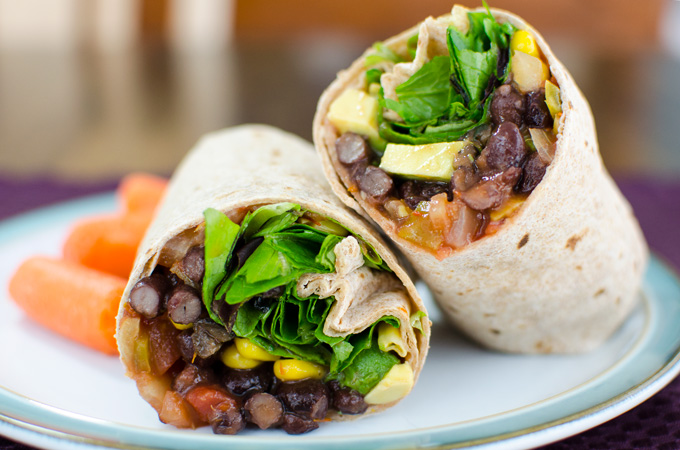Part 1 of my plant-based meal planning guide helped you define your food philosophy, analyze your plate and create a flexible meal-planning environment. Now I’m going to show you how I make it work for my family by sharing my basic plant-based meal plan for breakfast, lunch, snack, and dinner.

Breakfast
I usually begin my day with:
- ½ cup cooked (or soaked) whole grains
- ¼ cup nuts or seeds
- ½ cup frozen berries
- 1 small banana or ¼ cup dates and raisins
- ½ tsp. ground cinnamon or pumpkin pie spice
I rotate between variations of my Raw Vegan Oatmeal Mix and my Instant Pot Buckwheat Porridge. (Instant pot quinoa and millet porridge are also tasty.)

On oatmeal days, I let the mixture soak while I do my morning stretches and tend to other activities related to my morning routine. Same goes for cooking grains in the Instant Pot, except I make enough for three or four servings. So, on the days when I have leftovers, I simply heat the porridge in the microwave for about a minute and a half. Then I add frozen berries (also warmed in the microwave) and nuts or seeds.
My husband usually makes himself a bowl of old-fashioned oats in the microwave and adds frozen berries and sliced banana. Our daughter prefers to begin her day with a smoothie. Our son recently graduated from college and moved to Washington D.C. – so I can only guess what he eats for breakfast.
Lunch
My mid-day meals generally consist of:
- 1 cup raw greens or ½ cup cruciferous vegetables
- ½ cup non-leafy vegetables
- ½ cup cooked grain, pasta, or 1 tortilla
- ¼ cup bean spread or ½ cup cooked beans, lentils, or tempeh

How these ingredients come together depends on my mood and what I have on hand. In addition to staples like cooked rice and baked sweet potatoes, I like to keep one or two home-made sauces or dressings in the fridge:
I might enjoy a wrap with cooked beans, chopped veggies, raw greens, and sauce, dressing or salsa. Or I might toss these ingredients with some reheated cooked brown rice in a bowl.
My husband and daughter also enjoy sandwiches and bowls, but they usually add meat. My husband broils or slow-cooks chicken, pork or beef a couple of times a week to include with their meals. The great thing about bowl food is each family member can tailor their dish to taste.
Snack
I often enjoy a smoothie for an afternoon snack – which usually equates to:
- 2 cups cut-up fruit (1 cup is usually frozen)
- 1 cup raw greens or ½ cup cruciferous vegetables (depending on lunch selection)
- 1 tablespoon ground flax seed
- ¼ tsp. turmeric and/or ginger

Dinner
My approach to dinner is similar to my approach to lunch and features the same range of foods:
- 1 cup raw greens or ½ cup cruciferous vegetables (depending on lunch and snack selection)
- ½ cup non-leafy vegetables
- ½ cup cooked grain, pasta, or 1 tortilla
- ¼ cup bean spread or ½ cup cooked beans, lentils, or tempeh

Again, how these ingredients come together depends on what I have on hand and what else I have eaten during the day. If I enjoyed a wrap for lunch, I might be in the mood for something like Lentil Taco Salad for dinner.
Basic Plant-Based Meal Plan
As discussed in Part 1, the trick is to keep your fridge and pantry stocked with ingredients that allow each family member to quickly pull together a meal with healthy ingredients when they are hungry. In Part 1, I also shared an Analyze Your Plate graphic (shown below) that illustrates how to balance the different kinds of plant-based foods you eat over the course of days and weeks. Here in Part 2, I have provided a basic formula for each meal:
- Breakfast = whole grains, fruits, nuts or seeds
- Lunch = vegetables, whole grains, legumes
- Snack = fruits, vegetables, nuts or seeds
- Dinner = vegetables, whole grains, legumes

While a variety of resources influence my approach to eating, I think Dr. Greger (author of How Not To Die and founder of nutritionfacts.org) offers one of the simplest ways to stay on track. I recently discovered his Daily Dozen App – which allows you to log your intake of plant-based foods. It shows you serving size, recommended daily servings and examples for each group. The app is free, easy to use, and offers a perfect way to monitor your daily intake if you are a fly-by-the-seat-of-your-pants, figure-it-out-as-you-go-along meal planner like me. But it’s also an excellent reference if you like to plan your meals in advance.
I hope you found this glimpse into how I manage my plant-based meals while cohabitating with meat-eaters helpful. I welcome comments and questions!

Note: This article is based on my experience and represents my opinion. It is not intended to be a substitute for professional medical advice or treatment. Do not disregard professional medical advice or delay seeking it because of the information shared here. Also, this page contains affiliate links. I may earn a commission if you use a link. I only recommend items/brands I use and trust.
Original article and pictures take veggieprimer.com site
Комментариев нет:
Отправить комментарий